A Chronological Account Leading Up to Tuesdays Stock Market Meltdown in the Dow Jones Index
InvestorEducation / Elliott Wave Theory Mar 06, 2007 - 09:56 AM GMTBy: Joseph_Russo
The Power of Chart Technical Analysis and Price Forecasting - In the highly competitive and at times controversial, rough and tumble financial forecasting sphere, maintaining resident impartial disciplines, and "getting it right more often than not," is virtually the closest possible reality toward capturing the Holy Grail that we know of.
Trading, investing, and managing any sum of money is an inherently risky but highly rewarding endeavor. Traders and Managers of all stripes have "big money" on the line every day, year after year. Exposed in equal measure, open positions are continually subject to both inherent risks and substantial opportunities that evolve with the passage of time. Time is critical to this equation and waits for no one. Other than by way of mere chance, time is completely void of accommodation in facilitating individual outcome preferences. Time and price evolve dynamically irrespective of participants' collective time horizons or tolerance for risk. Given this, adopting a reliable primary or secondary financial forecasting source would check risk and balance profits in all time frames.
What follows are chronicled price charts of the Dow Jones Industrial Average leading up to the market meltdown of Feb-27, 2007:
Chart Journal Entries:
Thursday February 8, 2007 - 12-Trading Sessions before the Meltdown :
Our reflective journal entries begin with our short-term traders' chart presented in Elliott Wave Technology's Near Term Outlook and Day Traders Perspective for Friday February 9, 2007: Note the 12794.30 upper price target set off to the right of the chart almost two weeks in advance of the key pivot high:
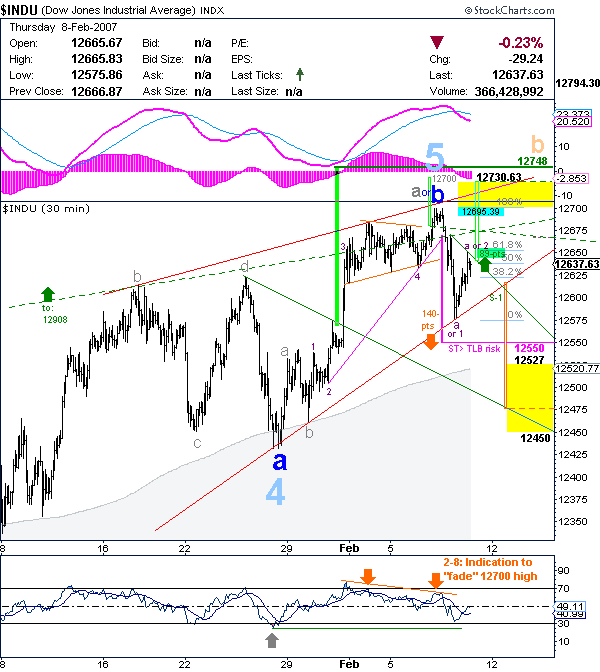
NOTE: The intraday price high prior to the meltdown occurred 12 days hence on Tuesday February 20th at 12,795.93, just 1.63 pts above the upper price target of 12794.30 cited above. Leading up to the chart above, we had just come off a profitable short-term bullish signal issued back on January 30th from the 12460 level. The last chart issued prior to the one above was delivered on Friday February 2nd alerting traders to take profits on previous longs and to reverse short against the 12683 high . We issued that short signal despite the fact that minimum entry to our upside price capture window at 12695.39 had yet to be achieved. As it turned out, from the sell alert issued on Friday the 2nd, the Dow was still in what then appeared to be a smaller fourth wave decline. By Thursday February 7th, this smaller fourth wave down concluded and reversed the Dow higher up to a fresh intraday high of 12,700.28 by the close. As long as traders left more than 18-pts cushion above the sell signal as a buy-stop, they remained positioned to the short side fading the 12700 spike high. The February 9th forecast provided further confirmation that short-term traders should remain bearish the previous days push higher. Such guidance also provided short-term traders another opportunity to "sell" the market if they had not done so the week prior.
Friday February 9, 2007 - 11-Trading Sessions before the Meltdown :
This journal entry prepared traders to take profits on recent shorts and reverse long via the below chart presented in Elliott Wave Technology's Near Term Outlook and Day Traders Perspective for Monday February 12, 2007:
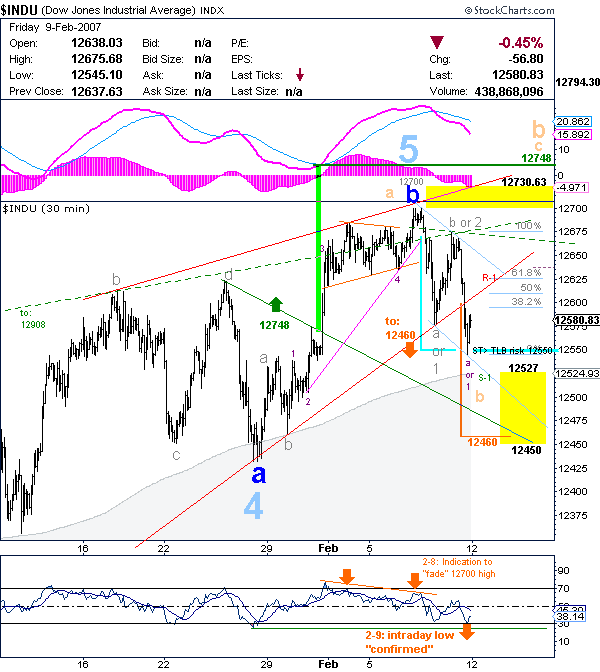
Holding bearish posture and maintaining short positions that were triggered from the 12680 level on February 2nd, this fresh leg down on Friday the 9th placed open trades in 100-pts profit. Notable in the forecast for February 12th is the achievement of a ST> TLB downside risk target at 12550. The intraday low was 12545.10 and the session closed at 12580.83. Such advance-targeted guidance measures routinely provide short-term traders with the option of presetting exit targets accordingly or in this example, booking 100-pts in profit on the trade. Those remaining short over that weekend took comfort in the confirming print low noted at Friday's session. Regardless of the tentative wave counts in this time frame, the market had become quite oversold. As such, we immediately began preparing traders for an imminent reversal higher. We suggested that traders who remained short over the weekend prepare to take profits on shorts and go long on a high probability tactical follow through low the following Monday.
Tuesday February 13, 2007 - 9-Trading Sessions before the Meltdown :
Our next journal entry highlights the chart presented in Elliott Wave Technology's Near Term Outlook and Day Traders Perspective for Wednesday February 14, 2007 signaling confirmation of a ST long position which eventually captured the last 240-pt upside push prior to the big meltdown.
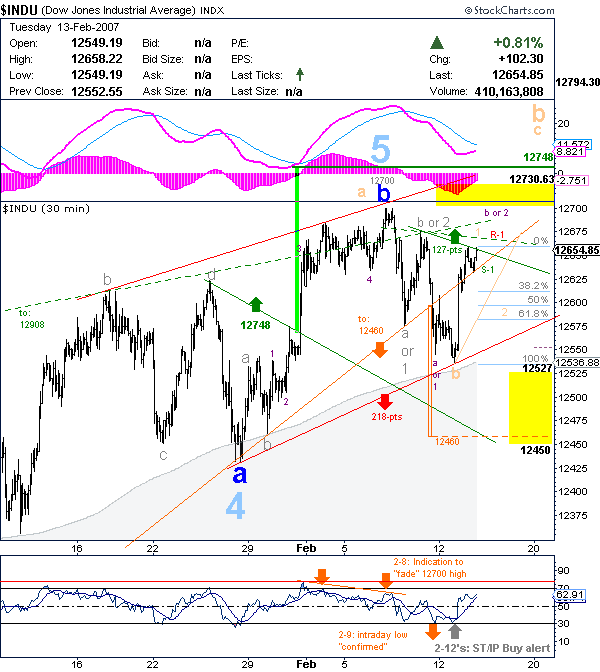
In the forecast for February 14th we identify "buy-side" confirmation against the tactical low mentioned in our prior report. On Monday February 12, the Dow printed a marginal new low of 12536.21 signaling a ST/IP Buy alert. Prepared well in advance, our short-term traders were now positioned long the market. Though quite useful, it is clear that tentative and alternate wave counts do not drive our short-term navigational guidance. Traders now long, have three upside targets with which to calculate risk vs reward levels relative to their individual trading strategies, and risk management protocols. The targets presented were 12730.63, 12748, with an outlier upside target of 12794.30 .
Thursday February 15, 2007 - 7-Trading Sessions before the Meltdown :
In the next journal entry, the chart presented in Elliott Wave Technology's Near Term Outlook and Day Traders Perspective for Friday February 16, 2007: alerted traders to take profits on recent longs and reverse to the short side of the market. The forecast guidance contained in this journal positioned traders on the right side of the market in advance of the sizeable one-day meltdown.
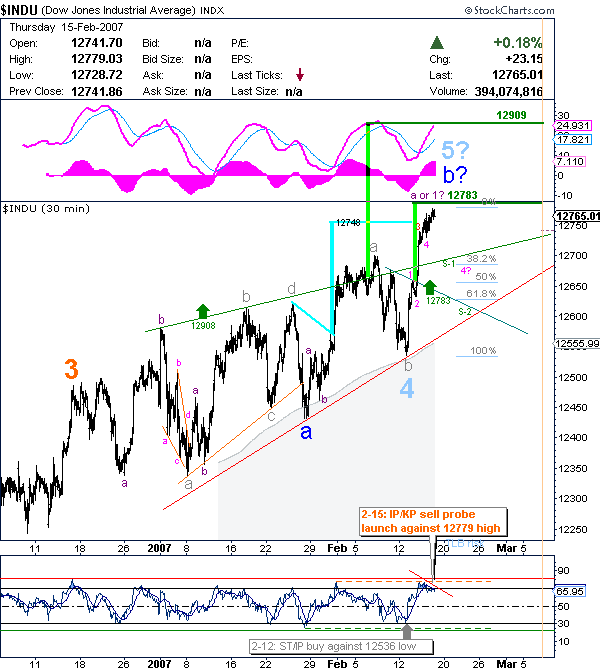
In the forecast for February 16th , one session prior to the 12795.83 print high , we alerted traders that the previous session high on February 15th of 12779.03 generated a signal to take profits on longs, and reverse short. (As an aside, short-term traders have access to our satellite charts running in real time at StockCharts.com . Though void of annotation, these satellite charts enable our traders to monitor and adjust to intraday developments and all price action that takes place between forecasts.) At the time, although we were expecting a key pivot high, we could not be certain that one was firmly in place.
Observe how the tentative and alternate short-term wave counts dynamically adjust to the price action with each passing chart. Uncertain that a key pivotal high had passed, we made it clear to our readers that a smaller four wave down might still be unfolding with a marginal new high to follow. We noted its possible base area below S-1 at the .382 retracement level of the last leg up. Practicing our discipline as a routine matter of course, we issued a sell probe alert to our clients regardless of such possibility. Further reason to take profits on longs and reverse short was that the Dow had achieved most of the resting upside price targets with the exception of the highest outlier. We noted with added interest that Thursday's price action provided us with a fresh new upside price target of 12783. We further noted that so long as trade remained above the S-1 level, the new 12783 price target and the resting 12794 outlier remained fair game . Regular guidance parameters such as these routinely provide our clients with extraordinary competitive advantage in setting stops, and placing exit order limits. Our traders were now short per February 16ths guidance, armed with advance knowledge that risk to short positions should be assessed from levels sufficiently above the 12794 outlier. In addition, strident bulls that may have elected to stay long despite our guidance now had two additional exit targets from which to elect taking profits.
Tuesday February 20, 2007: THE DAY OF THE PRINT HIGH;
5-Trading Sessions before the Meltdown :
The next journal captures the day of the key print high with a chart presented in Elliott Wave Technology's Near Term Outlook and Day Traders Perspective for Wednesday February 21, 2007:
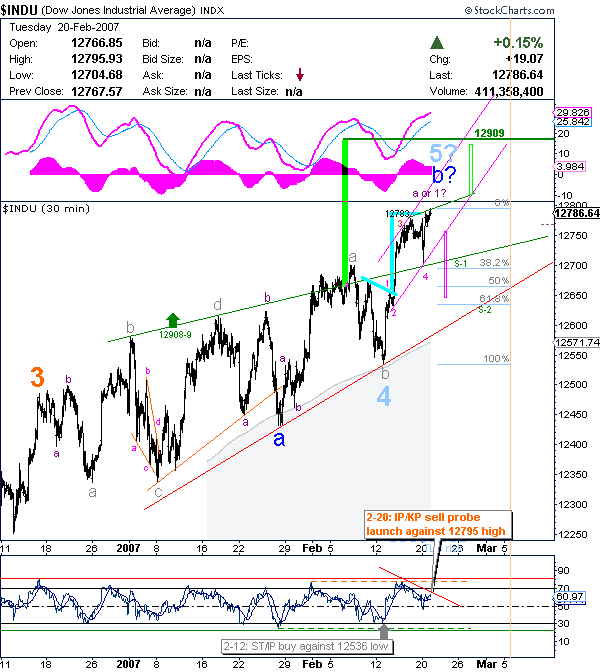
Notable in the forecast penned for Wednesday February 21st , is the highlighted achievement in reaching the most recent upside price target of 12783. Though somehow lost in translation between reports, the resting upside outlier target of 12794.30 forecasted early in the month was also achieved on this chart. Although the market seemed as if it would never go down, we maintained bearish guidance and restated a secondary sell probe fading the intraday top tic of 12795.93.
Friday February 23, 2007: 2-Trading Sessions before the Meltdown :
In addition to guiding position traders and active investors toward reducing size into Februarys rally, we also advised swing traders to remain short. The next journal entry captures a cautionary buy probe directed toward the most aggressive of short-term traders. The following chart presented in Elliott Wave Technology's Near Term Outlook and Day Traders Perspective for Monday February 26, 2007 displays our prudent commitment toward consistency in guidance for each style of trader/investor.
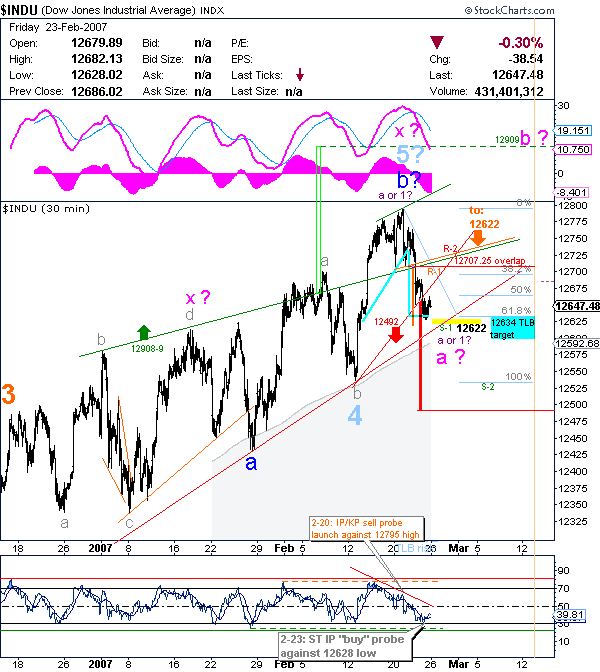
In the forecast for February 26th , we advised swing traders maintain short positions against any reaction rallies which did not exceed 12707.25, or the rising trend line resistance at R-2. Still uncertain that a final top was in, we penned out the last remaining alternate count (purple labels) as contingency for a final thrust higher. We alerted the most aggressive of short-term traders that a first downside target had been captured at the 12634 level. We advised aggressive traders who took profits and held long over the weekend about key resistance levels just above the market at R-1. We stressed in this report that a short-term sell trigger had been elected on Friday citing 12492 as first minimum downside target.
Despite this, we stuck to our disciplines and issued a very aggressive short-term buy probe against Fridays 12628 lows in anticipation of a bounce the following Monday. Of additional key relevance, was our guidance in conveying the key overlap level of 12707.25. This was a concise measure in drawing the line between bearish downward impulse vs a ST bullish corrective decline. We advised that if Fridays 12628 low held bottom and the market printed above 12707.25 on Monday, then the recent moves down were likely corrective and new highs would follow. We further clarified, that any reaction rally rejected from below this key overlap reversing the market back down below Fridays print low of 12628.02, would confirm a solid impulsive decline coming off an eight month bullish run. With such routine guidance, even the most aggressive of trade set-ups contain actionable boundaries from which to formulate targets, stops, and evaluate risk/reward.
Tuesday February 27, 2007: THE MINI GRAY DAY OF RECKONING :
The next journal captures the day of the big meltdown with a chart presented in Elliott Wave Technology's Near Term Outlook and Day Traders Perspective for Wednesday February 28, 2007:
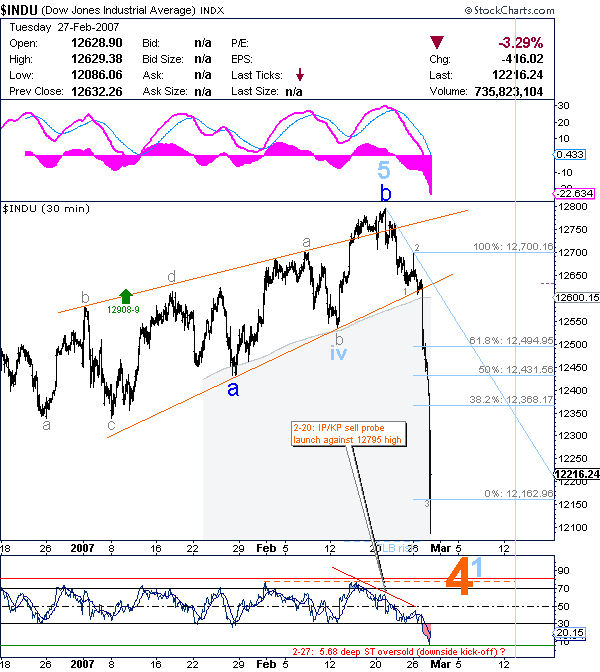
In the aftermath of Tuesday's big meltdown, the chart for February 28th shows a spike high of 12697.23 occurring on the Monday prior. We trust that our very aggressive short-term traders holding longs on Monday were extremely cautious when Mondays spike high began to reverse sharply shy of the previously cited 12707-overlap boundary. We trust our most astute traders (aggressive enough to take Fridays long probe in the first place) would have been keen on taking any open profits on Monday's 69-pt intraday bounce off Fridays low and reversed back to the short side rejoining their swing trading counterparts. Likewise, we trust that aggressive traders not so quick on the draw would have had resting sell stops in place to close out longs and reverse back short on the key lower boundary breach of Fridays previous low. We had recently reminded all of our clients of the potential severity in decline associated with a decisive breach in the lower boundary line of a long observed rising wedge pattern developed from the start of the year.
After printing a bearish intraday impulse low of 12608.47, over 19-pts below the previous Friday's key low, the Dow closed Monday's session down -15.22 at 12632.26. Those who failed to heed concise boundary parameters, warnings, and general guidance simply got what they deserved on Gray Tuesday. Since we did not receive one single piece of negative feedback surrounding the aggressive long probe on the 23rd, we can only surmise that all of our traders were well prepared and "did the right thing" in properly positioning themselves well out of harms way by the close of trade on Monday.
The last chart of our journal appears exclusively in the Near Term Outlook . Daily charts offer a slightly larger view, adding depth and perspective for longer-term position traders and investors.
Tuesday February 27, 2007: THE MINI GRAY DAY OF RECKONING:
Our last chart journal captures Gray Tuesdays big market meltdown with a chart presented from Elliott Wave Technology's Near Term Outlook for Wednesday February 28, 2007:
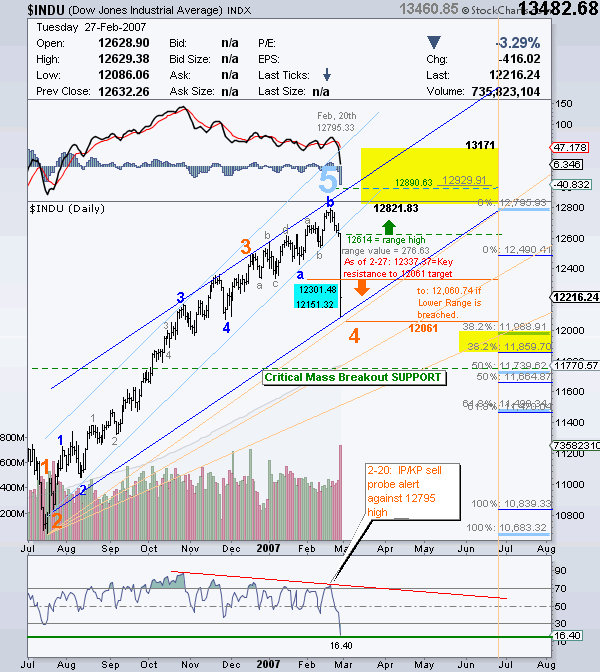
The daily chart above speaks quite clearly on its own.
Supplying individual traders and professional money managers with timely access to consistent and accurate price forecasting is a "mission critical" guidance responsibility we take very seriously . You might have the body armor, air support, and ammo, but without checks & balances, good intelligence, and rock-solid navigational guidance, all the weapons and technology in the world will likely fall short of getting the job done, and may potentially cause serious casualties.
Part science, part art, in concert with intense passion and rigorous labor; the chart journals above graphically depict the arresting nature and immense power that properly channeled forecasting disciplines are capable of producing.
There is no better time than present to acquire a fresh alternative forecasting perspective. Do ally with us in fighting the good fight in a never-ending war that has recently escalated substantially.
The charts above depict but one of many broad based indices similarly covered in the Near Term Outlook. In addition to the Dow, the Near Term Outlook delivers unrivaled forecasting coverage for the US dollar, S&P500, Gold, Crude Oil, the HUI, and the NDX!
Profits Up,
PS
Elliott Wave Technology will soon have available a limited number of coupon codes worth 50% off introductory issues of our Near Term Outlook . You may request your coupon codes by sending us an e-mail at Couponcodes@Elliottwavetechnology.com .
By Joseph Russo
Chief Editor and Technical Analyst
Elliott Wave Technology
Copyright © 2007 Elliott Wave Technology. All Rights Reserved.
Joseph Russo, presently the Publisher and Chief Market analyst for Elliott Wave Technology, has been studying Elliott Wave Theory, and the Technical Analysis of Financial Markets since 1991 and currently maintains active member status in the "Market Technicians Association." Joe continues to expand his body of knowledge through the MTA's accredited CMT program.
© 2005-2022 http://www.MarketOracle.co.uk - The Market Oracle is a FREE Daily Financial Markets Analysis & Forecasting online publication.



